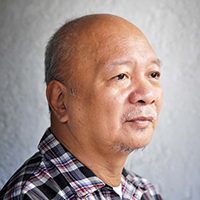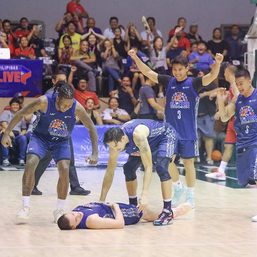SUMMARY
This is AI generated summarization, which may have errors. For context, always refer to the full article.
![[OPINION] Third telco: More fiction than real](https://www.rappler.com/tachyon/r3-assets/612F469A6EA84F6BAE882D2B94A4B421/img/87EA62BA42184C4F8A7467900074CBFB/thought-leaders-more-fiction-than-real-1.jpg)

Let’s go straight to the point. The much ballyhooed entry of a third player in the local telecommunications industry by March, 2018 is a brutal joke. It’s easier said than done.
The third telco player would have to hurdle several regulatory matters and corporate issues before it could compete with the duopoly of the Philippine Long Distance Telephone Company (PLDT) Group and Globe Telecommunications Group.
The corporate and regulatory processes could take at least 3 years, not 3 months, before the 3rd telco player could initiate operations, penetrate the local market, go full blast, and compete.
The corporate and regulatory issues do not include the national security dimensions of the third telco player’s entry. The national security issues appear complicated and multidimensional. Defense officials are in a better position to explain them.
What should be pointed out is that President Rodrigo Duterte could have been grossly, albeit indecently, misinformed when he made a public statement ensuring the entry of the third telco player by March this year and warning antagonistic parties from filing injunction suits to stop its entry.
Local firm
The first issue the prospective third telco player has to hurdle is the constitutional provision limiting foreign equity to only 40% of the total equity of public utility firms, which include telecommunications. The 60% of equity has to go to the local partner, making it the majority.
China Telecom, which the President has identified as the likely 3rd player, could not just enter the Philippine market, set up the infrastructure, and operate like a favored party without violating the 1987 Constitution. Ergo, China Telecom cannot operate as a wholly owned Chinese firm. Hence, it has to enter into a joint venture agreement with a local group to form a new firm, which will become the 3rd telco player.
Two groups have appeared on the horizon as likely partner of China Telecom, which, according to Duterte, has shown inordinate interest to enter the Philippine market: the Buddy Zamora group, which has acquired PT&T, a local firm*; and the Manny Villar group, which has acquired a telecommunications franchise from Congress, but has yet to form a telecommunications firm.
But going into a joint venture accord is a messy enterprise; they are not putting up a retail, or sari-sari, store. They are creating a behemoth firm to compete with two big telecommunications conglomerates: PLDT and Globe Telecom groups.
Forming a joint venture firm would take at least 6 months; it could go and drag for a year or two, as in most big firms. China Telecom and its local partner would have to conduct due diligence studies; each party has to determine the fitness of the other party as a joint venture partner.
Each party has to study their corporate and financial standing, prestige, technical and technological competence, and other legal, technical, and financial issues before any joint venture deal is sealed. Each has to look into the other party’s financial statements and corporate history.
Each party cannot afford to have a half-baked joint venture pact. Otherwise, this is something bound to fail. Forming a joint venture firm alone could consume the two parties the entire 2018.
Regulatory issues
Still, the newly formed joint venture firm could not just enter the local market and operate. It has to undergo the regulatory processes. The National Telecommunications Commission (NTC) is a quasi judicial body that has the plenary powers to determine the fitness of the 3rd telco player.
Republic Act 7925, or the Public Telecommunications Act of 1995, mandates the NTC to be the chief state agency dealing with the local telecommunications industry. Under the law, the NTC enjoys enormous powers as a regulatory body, as it is empowered to ensure a healthy and competitive environment and interconnection among telecommunications companies.
Even the Department of Information and Communications Technology (DICT), or any other state agency, could not interfere in its regulatory functions. The DICT merely monitors the NTC.
The Supreme Court’s decision in the Gamboa v. Teves case defines the foreign equity requirements under Section 11 of Article 12 of the 1987 Constitution to mean that 40% foreign equity in a public utility firm refers to common, or voting, stocks, not preferred, or non-voting stocks, or a mixture of common and preferred shares
Hence, foreign firms could not just circumvent what could be regarded as restrictive foreign equity requirement in every public utility firm.
Regulatory body
The NTC, as the regulatory body, would have to determine the fitness, capacity, and capability of the 3rd telco player to provide the myriad of telephony services and universal access to its potential subscribers. It has to know if the 3rd telco player has the financial muscle and technological knowhow to lay out the infrastructure and compete in the open market.
Moreover, the NTC would have to evaluate its plans and programs for the Philippine market and see if the 3rd telco player’s investments would go a long way to sustain a healthy and competitive domestic telecommunications industry. It has to evaluate its pre-feasibility and feasibility studies, its detail engineering works, and final plan and program to enter the market.
The NTC, given its history and technical knowhow, has to make the final decision on its entry. But the regulatory processes usually take time because they involve having to look into the intricacies and details of the 3rd player’s operations. Otherwise, the 3rd telco would end up a flop in the market.
Or the 3rd player would likely end up selling its assets to any of the existing duopoly and in the process strengthen the duopoly, which is not the ultimate aim of putting up a 3rd telco player in a market of 100 million Filipinos.
The President, on the other hand, could not impose his will to allow its entry without the NTC doing its job of fully examining its financial and technological fitness of the 3rd telco player. Aside from the usual legal issues arising from those presidential intrusions, the 3rd player would find itself in a tight legal fix if ever it chooses to cut corners and bamboozle its entry.
In the end, its forced entry would do more harm than good. It has no choice but to follow the usual regulatory processes and practices. Its own legitimacy would rest a great deal on doing its entry in the most legal ways.
Infrastructure works
Even if the 3rd telecom firm passes the NTC regulatory processes, it would take another year or two to lay down the basic infrastructures. For instance, putting up a wireless telephone service is not easy. The 3rd player has to put up those cell sites to actualize wireless telephone service.
Over the past 20 years, the duopoly of PLDT and Globe Telecom Groups has put up nearly 20,000 cell sites nationwide. This number is almost a quarter of the 75,000 cell sites, which Thailand now has.
Seeking permits from local government units (LGUs) to put up those cell sites is always a nightmare even for the duopoly. They have to cajole those officials of LGUs, including the 5th and 6th class municipalities’. In brief, the third teleco player would have to pass through the proverbial eye of a needle before it could set up the network.
This is not the end. The 3rd telco player would have to recruit the best and brightest among the local corps of telecommunications professionals. It has to employ outstanding financial and technical guys, who could run the firm. Getting the wrong guys is like flushing the money in the toilet.
The foreign partner could not just bring in foreign talents because the 1987 Constitution prohibits their employment. How the 3rd player would compete using the local pool of talents would be a spectacle. It does not happen easily.
In brief, it would take 3-4 years before the 3rd telco player could operate, go into the market, and compete. The Duterte administration would be lucky to have it toward the end of its term. Hitting the market by 2022 or 2023 is a safe prediction. – Rappler.com
*Disclosure: Zamora, Bitanga, and his son Miguel were named the new directors of PT&T last August 18, 2017. Miguel Bitanga is a co-owner of Dolphin Fire Group, an investment house owned by Menlo Capital Corporation. Dolphin Fire has a stake in Rappler.
Add a comment
How does this make you feel?





There are no comments yet. Add your comment to start the conversation.